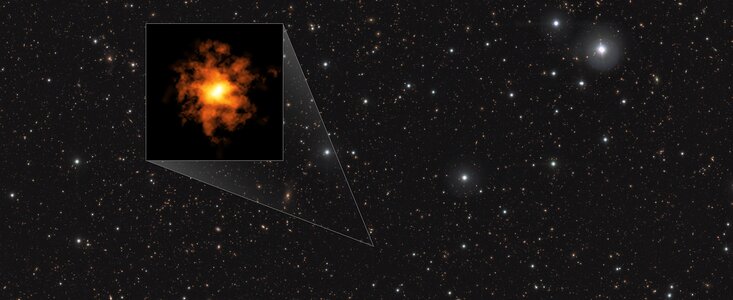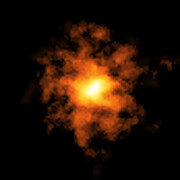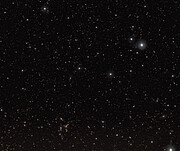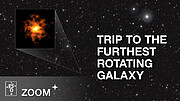Press Release
Space oddity: Most distant rotating disc galaxy found
7 October 2024

Researchers have discovered the most distant Milky-Way-like galaxy yet observed. Dubbed REBELS-25, this disc galaxy seems as orderly as present-day galaxies, but we see it as it was when the Universe was only 700 million years old. This is surprising since, according to our current understanding of galaxy formation, such early galaxies are expected to appear more chaotic. The rotation and structure of REBELS-25 were revealed using the Atacama Large Millimeter/submillimeter Array (ALMA), in which the European Southern Observatory (ESO) is a partner.
The galaxies we see today have come a long way from their chaotic, clumpy counterparts that astronomers typically observe in the early Universe. “According to our understanding of galaxy formation, we expect most early galaxies to be small and messy looking,” says Jacqueline Hodge, an astronomer at Leiden University, the Netherlands, and co-author of the study.
These messy, early galaxies merge with each other and then evolve into smoother shapes at an incredibly slow pace. Current theories suggest that, for a galaxy to be as orderly as our own Milky Way — a rotating disc with tidy structures like spiral arms — billions of years of evolution must have elapsed. The detection of REBELS-25, however, challenges that timescale.
In the study, accepted for publication in Monthly Notices of the Royal Astronomical Society, astronomers found REBELS-25 to be the most distant strongly rotating disc galaxy ever discovered. The light reaching us from this galaxy was emitted when the Universe was only 700 million years old — a mere five percent of its current age (13.8 billion) — making REBELS-25’s orderly rotation unexpected. “Seeing a galaxy with such similarities to our own Milky Way, that is strongly rotation-dominated, challenges our understanding of how quickly galaxies in the early Universe evolve into the orderly galaxies of today's cosmos,” says Lucie Rowland, a doctoral student at Leiden University and first author of the study.
REBELS-25 was initially detected in previous observations by the same team, also conducted with ALMA, which is located in Chile’s Atacama Desert. At the time, it was an exciting discovery, showing hints of rotation, but the resolution of the data was not fine enough to be sure. To properly discern the structure and motion of the galaxy, the team performed follow-up observations with ALMA at a higher resolution, which confirmed its record-breaking nature. “ALMA is the only telescope in existence with the sensitivity and resolution to achieve this,” says Renske Smit, a researcher at Liverpool John Moores University in the UK and also a co-author of the study.
Surprisingly, the data also hinted at more developed features similar to those of the Milky Way, like a central elongated bar, and even spiral arms, although more observations will be needed to confirm this. “Finding further evidence of more evolved structures would be an exciting discovery, as it would be the most distant galaxy with such structures observed to date,” says Rowland.
These future observations of REBELS-25, alongside other discoveries of early rotating galaxies, will potentially transform our understanding of early galaxy formation, and the evolution of the Universe as a whole.
More information
This research is presented in a paper entitled “REBELS-25: Discovery of a dynamically cold disc galaxy at z=7.31” to appear in Monthly Notices of the Royal Astronomical Society.
The observations were conducted as part of the ALMA Large Program REBELS: Reionization Era Bright Emission Lines Survey.
The team is composed of L. E. Rowland (Leiden Observatory, Leiden University, the Netherlands [Leiden]), J. Hodge (Leiden), R. Bouwens (Leiden), P. M. Piña (Leiden), A. Hygate (Leiden), H. Algera (Astrophysical Science Center, Hiroshima University, Japan [HASC]; National Astronomical Observatory of Japan, Japan), M. Aravena (Núcleo de Astronomía, Facultad de Ingeniería y Ciencias, Universidad Diego Portales, Chile), R. Bowler (Jodrell Bank Centre for Astrophysics, University of Manchester, UK), E. da Cunha (International Centre for Radio Astronomy Research, University of Western Australia, Australia; ARC Centre of Excellence for All Sky Astrophysics in 3 Dimensions), P. Dayal (Kapteyn Astronomical Institute, University of Groningen, the Netherlands), A. Ferrara (Scuola Normale Superiore, Italy [SNS]), T. Herard-Demanche (Leiden), H. Inami (HASC), I. van Leeuwen (Leiden), I. de Looze (Sterrenkundig Observatorium, Ghent University, Belgium), P. Oesch (Department of Astronomy, University of Geneva, Switzerland; Cosmic Dawn Center, Denmark), A. Pallottini (SNS), S. Phillips (Astrophysics Research Institute, Liverpool John Moores University, UK [LJMU]), M. Rybak (Faculty of Electrical Engineering, Delft University of Technology, the Netherlands; Leiden; Netherlands Institute for Space Research, the Netherlands), S. Schouws (Leiden), R. Smit (LJMU), L. Sommovigo (Center for Computational Astrophysics, Flatiron Institute, USA), M. Stefanon (Departament d’Astronomia i Astrofísica, Universitat de València, Spain; Grupo de Astrofísica Extragaláctica y Cosmología, Universitat de València, Spain), P. van der Werf (Leiden).
The Atacama Large Millimeter/submillimeter Array (ALMA), an international astronomy facility, is a partnership of ESO, the U.S. National Science Foundation (NSF) and the National Institutes of Natural Sciences (NINS) of Japan in cooperation with the Republic of Chile. ALMA is funded by ESO on behalf of its Member States, by NSF in cooperation with the National Research Council of Canada (NRC) and the National Science and Technology Council (NSTC) in Taiwan and by NINS in cooperation with the Academia Sinica (AS) in Taiwan and the Korea Astronomy and Space Science Institute (KASI). ALMA construction and operations are led by ESO on behalf of its Member States; by the National Radio Astronomy Observatory (NRAO), managed by Associated Universities, Inc. (AUI), on behalf of North America; and by the National Astronomical Observatory of Japan (NAOJ) on behalf of East Asia. The Joint ALMA Observatory (JAO) provides the unified leadership and management of the construction, commissioning and operation of ALMA.
The European Southern Observatory (ESO) enables scientists worldwide to discover the secrets of the Universe for the benefit of all. We design, build and operate world-class observatories on the ground — which astronomers use to tackle exciting questions and spread the fascination of astronomy — and promote international collaboration for astronomy. Established as an intergovernmental organisation in 1962, today ESO is supported by 16 Member States (Austria, Belgium, Czechia, Denmark, France, Finland, Germany, Ireland, Italy, the Netherlands, Poland, Portugal, Spain, Sweden, Switzerland and the United Kingdom), along with the host state of Chile and with Australia as a Strategic Partner. ESO’s headquarters and its visitor centre and planetarium, the ESO Supernova, are located close to Munich in Germany, while the Chilean Atacama Desert, a marvellous place with unique conditions to observe the sky, hosts our telescopes. ESO operates three observing sites: La Silla, Paranal and Chajnantor. At Paranal, ESO operates the Very Large Telescope and its Very Large Telescope Interferometer, as well as survey telescopes such as VISTA. Also at Paranal ESO will host and operate the Cherenkov Telescope Array South, the world’s largest and most sensitive gamma-ray observatory. Together with international partners, ESO operates ALMA on Chajnantor, a facility that observes the skies in the millimetre and submillimetre range. At Cerro Armazones, near Paranal, we are building “the world’s biggest eye on the sky” — ESO’s Extremely Large Telescope. From our offices in Santiago, Chile we support our operations in the country and engage with Chilean partners and society.
Links
- Research paper
- Photos of ALMA
- For journalists: subscribe to receive our releases under embargo in your language
- For scientists: got a story? Pitch your research
Contacts
Lucie Rowland
Leiden Observatory, University of Leiden
Leiden, The Netherlands
Tel: +31 71 527 2727
Email: lrowland@strw.leidenuniv.nl
Jacqueline Hodge
Leiden Observatory, University of Leiden
Leiden, The Netherlands
Tel: +31 71 527 8450
Email: hodge@strw.leidenuniv.nl
Renske Smit
Astrophysics Research Institute, Liverpool John Moores University
Liverpool, UK
Tel: +44-151-231-2922
Email: R.Smit@ljmu.ac.uk
Bárbara Ferreira
ESO Media Manager
Garching bei München, Germany
Tel: +49 89 3200 6670
Cell: +49 151 241 664 00
Email: press@eso.org
About the Release
| Release No.: | eso2415 |
| Name: | REBELS-25 |
| Type: | Early Universe : Galaxy |
| Facility: | Atacama Large Millimeter/submillimeter Array |
| Science data: | 2024MNRAS.535.2068R |
Our use of Cookies
We use cookies that are essential for accessing our websites and using our services. We also use cookies to analyse, measure and improve our websites’ performance, to enable content sharing via social media and to display media content hosted on third-party platforms.
ESO Cookies Policy
The European Organisation for Astronomical Research in the Southern Hemisphere (ESO) is the pre-eminent intergovernmental science and technology organisation in astronomy. It carries out an ambitious programme focused on the design, construction and operation of powerful ground-based observing facilities for astronomy.
This Cookies Policy is intended to provide clarity by outlining the cookies used on the ESO public websites, their functions, the options you have for controlling them, and the ways you can contact us for additional details.
What are cookies?
Cookies are small pieces of data stored on your device by websites you visit. They serve various purposes, such as remembering login credentials and preferences and enhance your browsing experience.
Categories of cookies we use
Essential cookies (always active): These cookies are strictly necessary for the proper functioning of our website. Without these cookies, the website cannot operate correctly, and certain services, such as logging in or accessing secure areas, may not be available; because they are essential for the website’s operation, they cannot be disabled.
Functional Cookies: These cookies enhance your browsing experience by enabling additional features and personalization, such as remembering your preferences and settings. While not strictly necessary for the website to function, they improve usability and convenience; these cookies are only placed if you provide your consent.
Analytics cookies: These cookies collect information about how visitors interact with our website, such as which pages are visited most often and how users navigate the site. This data helps us improve website performance, optimize content, and enhance the user experience; these cookies are only placed if you provide your consent. We use the following analytics cookies.
Matomo Cookies:
This website uses Matomo (formerly Piwik), an open source software which enables the statistical analysis of website visits. Matomo uses cookies (text files) which are saved on your computer and which allow us to analyze how you use our website. The website user information generated by the cookies will only be saved on the servers of our IT Department. We use this information to analyze www.eso.org visits and to prepare reports on website activities. These data will not be disclosed to third parties.
On behalf of ESO, Matomo will use this information for the purpose of evaluating your use of the website, compiling reports on website activity and providing other services relating to website activity and internet usage.
Matomo cookies settings:
Additional Third-party cookies on ESO websites: some of our pages display content from external providers, e.g. YouTube.
Such third-party services are outside of ESO control and may, at any time, change their terms of service, use of cookies, etc.
YouTube: Some videos on the ESO website are embedded from ESO’s official YouTube channel. We have enabled YouTube’s privacy-enhanced mode, meaning that no cookies are set unless the user actively clicks on the video to play it. Additionally, in this mode, YouTube does not store any personally identifiable cookie data for embedded video playbacks. For more details, please refer to YouTube’s embedding videos information page.
Cookies can also be classified based on the following elements.
Regarding the domain, there are:
- First-party cookies, set by the website you are currently visiting. They are stored by the same domain that you are browsing and are used to enhance your experience on that site;
- Third-party cookies, set by a domain other than the one you are currently visiting.
As for their duration, cookies can be:
- Browser-session cookies, which are deleted when the user closes the browser;
- Stored cookies, which stay on the user's device for a predetermined period of time.
How to manage cookies
Cookie settings: You can modify your cookie choices for the ESO webpages at any time by clicking on the link Cookie settings at the bottom of any page.
In your browser: If you wish to delete cookies or instruct your browser to delete or block cookies by default, please visit the help pages of your browser:
Please be aware that if you delete or decline cookies, certain functionalities of our website may be not be available and your browsing experience may be affected.
You can set most browsers to prevent any cookies being placed on your device, but you may then have to manually adjust some preferences every time you visit a site/page. And some services and functionalities may not work properly at all (e.g. profile logging-in, shop check out).
Updates to the ESO Cookies Policy
The ESO Cookies Policy may be subject to future updates, which will be made available on this page.
Additional information
For any queries related to cookies, please contact: pdprATesoDOTorg.
As ESO public webpages are managed by our Department of Communication, your questions will be dealt with the support of the said Department.






